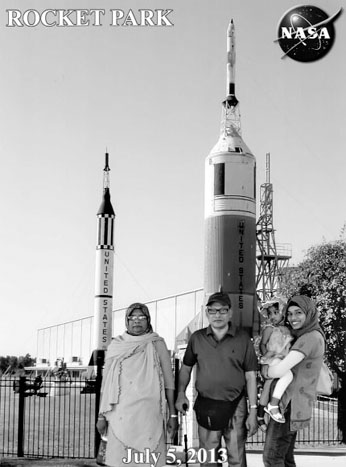
During our extended holiday in USA, my wife and I were travelling mostly in California, Oregon and Texas; transiting through Arizona. We went to Texas twice; first in Austin in December, 2012 while my eldest son-in-law, M Zahid Khondokar (Russel), Ph D was employed in the Texas University as a Post-Doctoral Research Fellow; and on the second occasion in Houston, in June, 2013 when Russel took up a job in the Chevron (one of the largest oil and gas companies in the world). The Chevron have three oval-shaped buildings in close vicinity as its headquarters; in downtown Houston. Two of them are 50-storied each where the Chevron's employees work and the 3rd one is a 30-storied building which is used for parking of vehicles of its employees. On a weekend I had had an occasion to visit Russel's office, nay the Chevron. There was a security guard we passed through at the entrance and Russel was quick to tell me that we were being watched since these buildings were under surveillance electronically.
So long we have discussed a tit-bit about the gigantic "Chevron", and now we move on to our core programme relating to the National Aeronautics and Space Administration (NASA). NASA is located about 40 miles from downtown Houston. My eldest daughter had drawn up a programme and on June 05, 2013 she drove us to NASA; known as Johnson Space Centre; named after Lyndon B Johnson who had succeeded John F Kennedy, a famed US President, after he had been killed by a gunman in Dallas in 1963. My granddaughter Zarin was fond of seeing everything.
It is said, once you are in Houston, must do visit Space Centre; and go on the ground in Johnson Space Centre.
Here many historic events are shown e.g. astronauts' training, historic mission control. Since 2011 US stopped sending human beings to the space; now unmanned robots do the study and research work in the space. This tour also took us through the new Saturn V Complex at Rocket Park. This is one attraction that's impossible to miss.
While we moved in the Tram Car from one building to the other, we saw rural background of NASA. Bison meat is served in big feasts as the one we had seen in TV screen when President Obama hosted his post-election dinner for the celebrities from all walks of life and society in USA.
In the next building were awaiting us more exciting things to see. From the catwalk high above the massive floor, we saw several mock-ups of international space station parts and looked at new Orion Capsule and other new tech that will pave the way for future exploration. Cutting edge rovers, robots, next - level space suits. Here is where the impossible is happening - engineers and astronauts shaping the future of space exploration.
Saturn at Rocket Park: saying that it is unbelievably massive does not do it justice. This is Saturn V Rocket, the most powerful rocket ever built and operated. It played a major role in successfully transporting and landing American astronauts on the moon during Apollo missions. Over 36 stories tall, this Saturn V is one of only three left in existence. If man ever needed to go back to the moon, chances are this would be the rocket to get them there. Picture below shows our three generations beside the Replica of Saturn V.
Historic mission Control is located in Building 30 of Johnson Space Centre. Here NASA monitored nine Gemini and all Apollo missions including the historic Apollo 11 trip to the moon.
Shuttle avionics integration laboratory provided space Shuttle program where orbiter hardware and flight software came together to create a simulated flight environment; testing protocol, complete avionics of a mock-up of Shuttle and gives a life time at how crews trained for their Shuttle missions. It is used to be off limits to visitors but this piece of impossible tech is now a stop on the NASA Tram Tour. There are many more buildings where study and research were now being undertaken, are kept off limits. Our Tram Car Tour ended here and we were back to Jahnson Centre to depart for home with happy memories.
The article will be incomplete unless we know origin / creation of NASA. There were several agencies both in military and civilian sectors working and experimenting with rocket planes, artificial satellite, etc. including the oldest National Advisory Committee for Aeronautics (NACA) established in 1946. In the meantime, Soviet Union launched the world's the first artificial Satellite (Sputnik I) on October 04, 1957. This had prompted United States to take stock of its own fledging space efforts. Dwight D Eisenhower was then the US President (1952 - 1960). Earlier, he was the Supreme Allied Commander-in-Chief in the western war theatre. After the World War II General Eisenhower became the first NATO Supreme Commander. US Congress, alarmed by the perceived threat to national security and technological leadership went for immediate and swift action; and the US Congress passed the National Aeronautics and Space Act and had began its operation on October 01, 1958; incorporating / merging all similar agencies into NASA under civilian administration. Rest of the stories of NASA supremacy on the space are well-known and it still strives to further advancement of space research and study; although super power rivalry was largely diminished.
The writer is Ex-Commercial Secretary, Bangladesh High Commission, London, who can be reached at e-mail: ahsan_agency@yahoo.com
© 2025 - All Rights with The Financial Express
